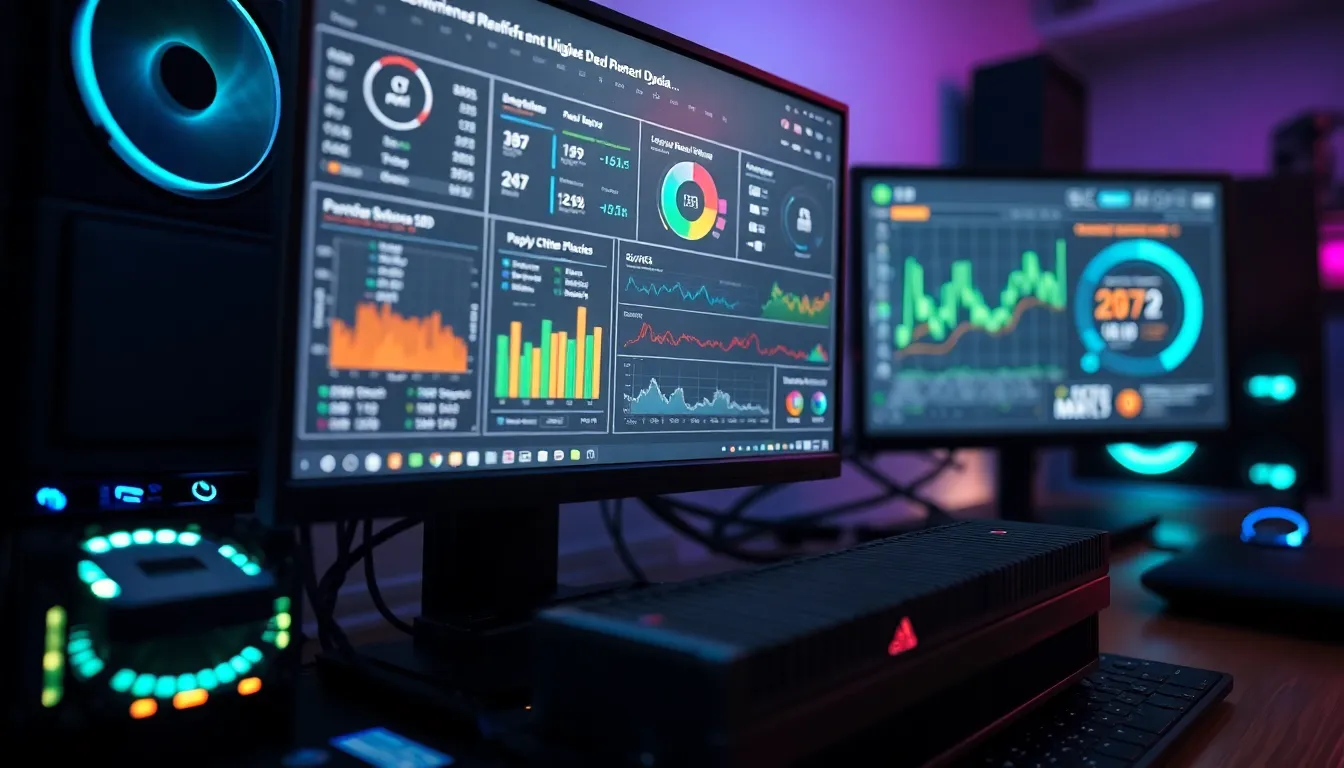In the fast-paced world of technology, hardware performance tests are like the gym sessions for your computer. Just as a fitness enthusiast wouldn’t skip leg day, tech enthusiasts can’t overlook the importance of testing their hardware. These tests reveal how well components like CPUs, GPUs, and RAM flex their muscles under pressure, ensuring everything runs smoothly.
Table of Contents
ToggleOverview of Hardware Performance Tests
Hardware performance tests assess the capabilities of computer components, ensuring they meet user needs. These evaluations determine how well CPUs, GPUs, and RAM handle various tasks. Testing reveals strengths and weaknesses in a system’s performance.
Different types of performance tests serve specific purposes. Benchmark tests measure the processing power and graphical output of hardware, while stress tests evaluate stability under maximum load. Both testing methods provide crucial insights.
Tech enthusiasts use results from these tests to make informed decisions. Upgrading components can enhance system performance, especially when gaming or running resource-intensive applications. Understanding performance metrics helps users identify bottlenecks that may hinder productivity.
Various tools exist to conduct hardware performance tests. Programs like Cinebench, 3DMark, and AIDA64 offer comprehensive evaluations of CPU and GPU performance. Each tool provides unique metrics that users can compare with industry standards.
Regular testing maintains optimal performance over time. Monitoring hardware metrics ensures components run efficiently and effectively. Users can identify signs of degradation, allowing for timely upgrades or repairs, similar to maintaining fitness regimens.
Testing hardware before significant upgrades helps avoid unnecessary expenses. Prioritizing performance evaluations can lead to significant improvements in system efficiency. Comprehensive testing strategies enable users to customize their setups for intended applications.
Ultimately, hardware performance tests play a vital role in the tech community. These evaluations ensure systems perform at their best, similar to pursuing physical fitness goals. Consistent testing keeps systems competitive in a rapidly evolving technological landscape.
Types of Hardware Performance Tests

Hardware performance tests play a crucial role in assessing component efficiency and ensuring optimal system operation. Various types help users understand different aspects of their hardware capabilities.
CPU Performance Tests
CPU performance tests evaluate processing power and efficiency. Benchmarking tools like Cinebench measure single-core and multi-core performance to compare chips. Users gain insights into how CPUs handle various tasks, revealing strengths in processing speed and multitasking ability. Stress tests also assess stability under heavy load, providing crucial information about thermal limits and power consumption. Results guide enthusiasts in selecting upgrades that enhance productivity.
GPU Performance Tests
GPU performance tests focus on graphical capabilities and rendering efficiency. Tools such as 3DMark benchmark various graphics tasks, including gaming and video editing scenarios. Evaluating frame rates, resolution, and image quality provides insights into the GPU’s performance in real-world applications. Stress testing reveals how graphics cards behave under maximum load, helping identify potential thermal throttling issues. Results inform gamers and content creators about suitable GPU choices for their needs.
Storage Performance Tests
Storage performance tests examine read and write speeds across different devices. Software like CrystalDiskMark measures data transfer rates to reveal SSD and HDD efficiencies. Users compare random and sequential write speeds, highlighting differences between storage types. Consistent performance testing uncovers potential bottlenecks, enabling enhanced storage solutions. These insights assist in selecting the best storage options, ensuring quick access and data retrieval.
Memory Performance Tests
Memory performance tests assess RAM efficiency and speed. Tools like AIDA64 measure latency, bandwidth, and stability to highlight memory’s impact on overall performance. Understanding how RAM interacts with other components ensures users optimize their configurations for specific applications. These evaluations pinpoint issues that may cause slowdowns, guiding users toward optimal RAM choices. Comprehensive testing supports better multitasking performance and system responsiveness, especially in demanding tasks.
Methods of Conducting Hardware Performance Tests
Various methods exist for conducting hardware performance tests. These methods provide crucial insights into the efficiency and reliability of computer components.
Benchmarking Tools
Benchmarking tools measure the performance of hardware against established standards. They quantify metrics such as processing power and graphics capabilities. Prominent tools like Cinebench, 3DMark, and AIDA64 stand out for their accuracy. Users leverage these tools to compare results and determine optimal configurations. Benchmark scores help identify weaknesses and strengths in system performance. By utilizing a combination of these benchmarking tools, tech enthusiasts can make informed decisions on component upgrades.
Stress Testing
Stress testing evaluates the stability and reliability of hardware under extreme conditions. This method subjects components to maximum loads, simulating real-world scenarios. Tools like Prime95 and FurMark are commonly used for CPU and GPU stress tests. During these tests, monitoring temperature and power consumption remains essential. Identifying performance bottlenecks becomes easier with stress testing. It highlights potential failures before they lead to hardware issues, ensuring peak performance during demanding tasks. Users can optimize their setups based on stress test outcomes, allowing for improved longevity and efficiency of their systems.
Analyzing Hardware Performance Test Results
Analyzing hardware performance test results involves examining the metrics obtained during testing. Each metric provides valuable insights into how well components function under various conditions. For instance, when evaluating a CPU, users should pay close attention to processing power and efficiency, as these directly impact overall system performance.
GPU test results highlight graphical capabilities and rendering efficiency. Users often compare scores from tools like 3DMark, allowing them to assess performance relative to industry standards. Storage performance tests focus on read and write speeds, revealing how quickly data transfers occur, which is crucial for application loading times and system responsiveness.
Memory performance tests measure RAM efficiency and speed. Notably, results from AIDA64 inform users about potential bottlenecks, assisting in optimizing configurations for gaming and resource-heavy applications. When comparing results, context helps form a clearer picture of component capabilities.
Regularly conducting tests establishes a performance baseline, allowing users to identify improvements or degradations over time. Data trends indicate when components may require upgrades or replacements, preventing unexpected failures during critical tasks. By understanding these trends, tech enthusiasts maintain optimal performance.
Ultimately, combining results from various test types offers a comprehensive overview of a system’s strengths and weaknesses. These insights guide informed decisions about upgrades, ensuring users can customize their setups to better meet demands in a technology-driven environment. Thus, systematically analyzing hardware performance test results becomes essential for maximizing efficiency and longevity.
Hardware performance tests are essential for anyone looking to optimize their technology. They provide valuable insights into component efficiency and system stability. By regularly conducting these tests, users can ensure their setups remain competitive and responsive to evolving demands.
Understanding test results empowers tech enthusiasts to make informed upgrade decisions and maintain peak performance. This proactive approach not only enhances user experience but also extends the lifespan of hardware. Embracing these testing practices is a smart strategy for anyone serious about maximizing their system’s potential.




